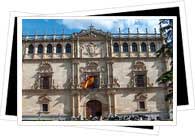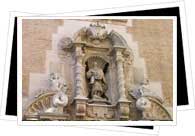Renaissance Architecture in Valencia, Spain
 Renaissance Architecture in Spain
Renaissance Architecture in Spain
Like most major European movements, the intellectual, artistic and architectural movement known as the Renaissance hails from Italy. Emerging and subsequently flourishing throughout the 15th and 16th centuries, it quickly seeped out of Italy and essentially engulfed all of Europe. Literally meaning "rebirth," the Renaissance boasted a reconnection with the concepts of classical Roman and Greek antiquity- rationality, balance, logic- and applied it to practically every facet of life. In terms of Spanish architecture, the "pure" Italian Renaissance style didn't quite hit it off right away in a country known for its flair for decoration. For this reason, Spanish Renaissance architecture forks into two distinct styles: Plateresque and High Renaissance.
Renaissance Architecture Characteristics
Plateresque Renaissance architecture in Spain used the classic shapes- perfect circles, squares, triangles- but integrated them into extremely stylized, over-the-top surface decoration. Plateresque architects didn't focus on the structural side of architecture but rather fixated on the decoration of already existing structures. Spain's High Renaissance, which finally took hold later on down the line, was more attuned to the artistic and architectural goals of its Italian counterpart.
Keeping with the underlying theme of a classical revival, elements of ancient Greek and Roman architecture once again made a major mark in Spain's High Renaissance. Keeping in mind structures like the great temples of antiquity, architects once again sought mathematical proportions, simplicity, order and symmetry. You're likely to see the incorporation of columns, a lot of clean lines, classic shapes and little decoration. Such adherence to order and "purity" gives these Renaissance structure a dignified air, a quality that you'll quickly pick up upon as you explore Valencia's Renaissance scene.
Renaissance Architecture in Valencia
 Valencia serves up an attractive array of Renaissance architecture- mainly of the High Renaissance variety. Head to the Iglesia de San Juan de la Cruz (Church of Saint Juan of the Cross), a Renaissance church boasting a modestly but elegantly decorated façade- keep an eye open for the twisting salomonic columns as well as the perfectly vaulted dome. Other examples of Renaissance architecture in Valencia include the cloister and church of Santa Cruz, found within the complex of the Convento del Carmen (Convent of the Carmen), and the Colegio Seminario del Corpus Christi.
Valencia serves up an attractive array of Renaissance architecture- mainly of the High Renaissance variety. Head to the Iglesia de San Juan de la Cruz (Church of Saint Juan of the Cross), a Renaissance church boasting a modestly but elegantly decorated façade- keep an eye open for the twisting salomonic columns as well as the perfectly vaulted dome. Other examples of Renaissance architecture in Valencia include the cloister and church of Santa Cruz, found within the complex of the Convento del Carmen (Convent of the Carmen), and the Colegio Seminario del Corpus Christi.
